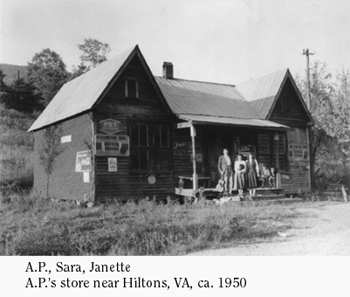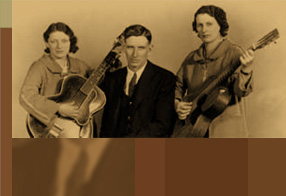Sound Clips
 Audio –
In a 1964 discussion of the War on Poverty and the Peace Corps, President
Lyndon Johnson surprises Sargent Shriver by wishing for some of Dr. Brinkley's
goat glands
Audio –
In a 1964 discussion of the War on Poverty and the Peace Corps, President
Lyndon Johnson surprises Sargent Shriver by wishing for some of Dr. Brinkley's
goat glands  Audio –
An "X"-station ad recommends "Crazy Water Crystals" for anyone plagued by
a "sluggish system."
Audio –
An "X"-station ad recommends "Crazy Water Crystals" for anyone plagued by
a "sluggish system."  Audio –
Worried about losing your job due to graying hair? Another "X"-station advertised
product, called Kolorbak, may be the answer.
Audio –
Worried about losing your job due to graying hair? Another "X"-station advertised
product, called Kolorbak, may be the answer.  Listen –
to the full web-only program
Click here for an authentic Carter Family poster
Listen –
to the full web-only program
Click here for an authentic Carter Family poster
"Anchored In Love" performed by Dale Jett, Janette Carter, and Joe
Carter. Recorded live at the Carter Fold by Maxine Kenny, producer of a 2-hour
WMMT/Appalshop radio documentary entitled "Anchored in Love: The Carter
Family Story." Used with the kind permission of and with gratitude to
the artists and WMMT/Appalshop
Special thanks also go to Mark Zwonitzer, co-author of Will You Miss Me
When I'm Gone? The Carter Family and Their Legacy in American Music,
(Simon and Schuster, 2002.) along with Charles Hirshberg.
 Humanities
Themes : Humanities
Themes :
The Border Radio Phenomenon.
The "X" stations, situated south of the border in order to get
around the Federal Radio Commission's regulations, were designed to send
a signal all the way to Canada and beyond. For decades, beginning in the
1930s, stations such as XER, XERA, XERF, XEG and the rest attracted hordes
of listeners, eager to hear musical performers and be swayed by pitchmen
selling everything from Crazy Water Crystals to baby chicks, tomato plants
to Last Supper tablecloths and autographed pictures of Jesus.
Economics of Radio.
Radio's advertising potential led to the development and success of the
X stations. Pioneers of mega-watt border broadcasting––entrepreneurs
like Dr. John Brinkley (the goat-gland doctor)––were well
aware of the huge reach of a powerful radio signal and the income possibilities
from dispensing wares and cures on the air. On the other hand, performers
such as the Carter Family reaped enormous promotional rewards from their
appearances on border radio.
Radio and dissemination
of musical style. Radio shows such as the Grand Ole Opry on WSM Nashville,
the National Barn Dance on WLS Chicago, and the Wheeling Jamboree on WWVA
Wheeling, West Virginia, popularized hillbilly and country music during
the '30s, '40s and beyond. But it was use of the X stations that was the
major factor in spreading awareness of these musical styles.
Storylines:
The development of
the X stations and the part radio––especially the "border-blaster"
broadcasts––played in the history of country music.
 A largely rural listener
base was significant in the economics of the border radio stations and
an important factor in the decision to use hillbilly and country talent
on the air. A largely rural listener
base was significant in the economics of the border radio stations and
an important factor in the decision to use hillbilly and country talent
on the air.
A look at the career
of the Carter Family, one of the most influential groups in country music
history.
How did the border
radio broadcasts of hillbilly and country music artists, the Carter Family
in particular, influence other musical groups––both their
contemporaries and musicians in the following decades?
Interview
Subjects:
Janette Carter,
daughter of A.P. and Sara Carter, and manager of the Carter Fold, a concert
barn in Hiltons, Virginia. Janette and her cousins performed with the
Original Carter Family on the border radio stations.
June Carter
Cash, daughter of Maybelle (and Ezra) Carter. Performed with
her family on border radio programs. She was quoted as remembering that
you could hang a tin can on any barbed-wire fence in Texas and hear the
Carter Family. (Wolfe, Country Classics, p. 10)
Gene Fowler/Bill
Crawford, authors of Border Radio: Quacks, Yodelers, Pitchmen,
Psychics, and Other Amazing Broadcasters of the American Airwaves.
(Austin, Texas Monthly Press, 1987)
Mike Seeger,
musician, scholar, John Edwards Memorial Foundation Trustee.
Charles K.
Wolfe, professor of English and folklore at Middle Tennessee
State University and a leading expert on the history and development of
country music.
Background
Who could imagine
that when Dr. John Romulus Brinkley's dubious Milford, Kansas, medical
practice ran into trouble, it would lead to one of the most influential
periods in the development of country music?
The smooth-talking
Brinkley made a name for himself in Milford in the early 1920s. His chief
claim to fame was his "revitalization" surgery––transplanting
goat testicles into older men, eager to reclaim their youthful vitality.
Dr. Brinkley, who amassed a small fortune transplanting goat glands and
peddling other questionable cures, obtained authorization from the Department
of Commerce to build a radio station, and in September of 1923, KFKB ("Kansas
First, Kansas Best") went on the air––"the Sunshine
Station from the Heart of the Nation." KFKB became the perfect vehicle
for Dr. Brinkley to expand his practice. His following grew as he dispensed
medical advice on the airwaves. "But, oh my friends," he would
tell his listeners, "you must help me. Remember your letters asking
advice must be accompanied by two dollars ..."
By the late '20s,
John Brinkley had attained enormous wealth; he'd also accumulated his
share of detractors. The AMA labeled him dangerous, and in the spring
of 1930, the Kansas City Star began a series of articles aimed at exposing
Brinkley as a fraud. Ultimately, the doctor was hauled into court and
stripped of his medical license. Brinkley countered by running for governor
as a write-in. But probably due to the vague election rules regulating
write-ins––almost 200,000 ballots were tossed out
for write-in irregularities––the doctor lost the election.
The next year, 1931,
after the Federal Radio Commission refused to renew his broadcasting license,
Dr. Brinkley announced plans to build a radio station in Mexico––XER,
in Ciudad Acuña, Mexico––just across the border from
Del Rio, Texas. The 500,000-watt station was free from the encumbering
regulations of the FRC. And while the Mexican government shut XER down
in 1934 for broadcasting in English only, it reappeared as XERA in 1935
with a signal that rose to a reported 1,000,000 watts––"the
world's most powerful broadcasting station."
Many hillbilly and
country acts were hired by XERA and other border radio stations. Perhaps
the most significant was The Carter Family, A.P., Sara and Maybelle, as
well as A.P. and Sara's daughter, Janette, and Maybelle's children, Helen,
June and Anita. For approximately three years, beginning in 1938, the
Carter Family could be heard––both live, and later via radio
transcriptions––on XERA and various sister stations across
the border. They were sponsored by the Consolidated Royal Chemical Corporation,
which sold Peruna ("...to knock out the torture of colds ... ")
and Kolorbak ("... scientifically imparts color and charm to gray
hair ...").
The Carters became
known nationwide and enjoyed increased record sales as a result of their
border radio years. According to Charles K. Wolfe, "This gave them
the largest radio audience they ever had, and soon even the old Bluebird
[label] records were selling like wildfire." And in the decades that
followed, many country artists credited the Carter Family as their inspiration.
The story goes that Waylon Jennings, growing up in Littlefield, Texas,
remembered back to being about four years old when his father used to
pull the truck up beside the house and run a cable from the battery to
the radio so he could listen to the Carter Family on XERA. Johnny Cash,
too, remembered hearing the Carter Family (including 10-year-old June,
whom he would marry some three decades later) on the border radio broadcasts.
The border stations,
wrote Bill C. Malone, "popularized hillbilly music throughout the
United States and laid the basis for country music's great popularity
in the late '40s and early '50s."
Resources:
Bibliography, Discography, Archival
Books:
Fowler, Gene/Crawford,
Bill. Border Radio. (Austin, Texas Monthly Press, 1987.)
Lee, R. Alton. The
Bizarre Careers of John R. Brinkley. (University Press of Kentucky,
2002.)
Malone, Bill C. Southern
Music/American Music. (University Press of Kentucky, 1979.)
Malone, Bill C. Country
Music U.S.A. (University Press of Texas, 1985.)
Malone, Bill C. Don't
Get Above Your Raisin': Country Music and the Southern Working Class.
(University of Illinois Press, 2002.)
Orgill, Michael. Anchored
in Love: The Carter Family Story. (Fleming H. Revell Company, 1975.)
Wolfe, Charles K.
Classic Country: Legends of Country Music. (Routledge, 2001.)
Recordings:
The Carter Family
on Border Radio. JEMF 101. (LP) Radio transcriptions.
The Carter Family
on Border Radio from Radio Station XET Monterrey N.L. Mexico 1939, 3 vols.
(Arhoolie Records/Arhoolie Productions, 1995.) A collection of transcriptions
the Carter Family, including the Carter children, made in San Antonio,
Texas, in 1939 for broadcast on radio station XET, Monterrey, Mexico.
Includes liner notes by Ed Kahn.
Gospel Songs by the
Carter Family in Texas. Old Homestead. OHCS 116. (LP) Radio transcriptions.
The Carter Family:
In The Shadow of Clinch Mountain. Bear Family Records Bcd15865lk
Twelve-CD set, includes book by Charles Wolfe. 12th CD includes a previously
unissued 40-minute 1963 interview with Sara and Maybelle Carter by Mike
Seeger and Ed Kahn, four previously unissued duets by Sara and Maybelle
recorded by Seeger and Kahn at Sara’s home in Angel’s Camp,
CA., and an LP interview with Maybelle Carter, which was circulated to
DJs in 1973 but not otherwise made available. In it she talks about everything
from autoharps and fingerpicking to tales of her first Grand Ole Opry
appearance and the early days of radio.
Articles:
Kahn, Ed. "The
Carter Family on Border Radio," in American Music: A Quarterly
Journal Devoted to all Aspects of American Music and Music in America,
vol. 14, no.2 (summer 1996): pp. 205-217.
Kahn, Edward A., II.
The Carter Family: A Reflection of Changes in Society. (Ph.D. dissertation.,
Anthropology: University of California Los Angeles, 1970.)
Websites:
The Carter Family
Memorial Music Center, Inc. (Carter Fold) Hiltons, Virginia. http://www.fmp.com/orthey/carter.html#program
Aircheck Collection
of Steve Farrington: 1939 The Pickard Family--barndance, gospel--XERA
Del Rio, TX--from transcription discs See site: http://www.wakeatlanta.com/files/MyHTML5.html
Kansas State Historical
Society. http://www.kshs.org/cool/coolbrin.htm
The Broadcast Archive.
http://www.oldradio.com/
(and http://www.oldradio.com/archives/hardware/WE320A.htm.
Discussion of border station technology.) |


 Humanities
Themes :
Humanities
Themes : A largely rural listener
base was significant in the economics of the border radio stations and
an important factor in the decision to use hillbilly and country talent
on the air.
A largely rural listener
base was significant in the economics of the border radio stations and
an important factor in the decision to use hillbilly and country talent
on the air.